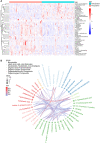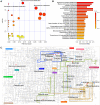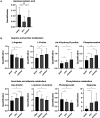Metabolomic profiling identifies biomarkers and metabolic impacts of surgery for colorectal cancer
- PMID: 36090329
- PMCID: PMC9453208
- DOI: 10.3389/fsurg.2022.913967
Metabolomic profiling identifies biomarkers and metabolic impacts of surgery for colorectal cancer
Abstract
Background: Colorectal cancer (CRC) is one of the most common malignant tumors with recurrence and metastasis after surgical resection. This study aimed to identify the physiological changes after surgery and explore metabolites and metabolic pathways with potential prognostic value for CRC.
Methods: An ultra-high-performance liquid chromatography Q-exactive mass spectrometry was used to profile serum metabolites from 67 CRC patients and 50 healthy volunteers. Principal component analysis (PCA) and orthogonal projections to latent structures-discriminant analysis were used to distinguish the internal characteristics of data in different groups. Multivariate statistics were compiled to screen the significant metabolites and metabolic pathways.
Result: A total of 180 metabolites were detected. Under the conditions of variable importance in projection >1 and p-value <0.05, 46 differentially expressed metabolites were screened for further pathway enrichment analysis. Based on the Kyoto Encyclopedia of Genes and Genomes database and Small Molecule Pathway Database, three metabolic pathways-arginine and proline metabolism, ascorbate and aldarate metabolism, and phenylalanine metabolism-were significantly altered after surgical resection and identified as associated with the removal of CRC. Notably, gamma-linolenic acid was upregulated in the CRC preoperative patients compared with those in healthy volunteers but returned to healthy levels after surgery.
Conclusion: Through serum-based metabolomics, our study demonstrated the differential metabolic characteristics in CRC patients after surgery compared with those before surgery. Our results suggested that metabonomic analysis may be a powerful method for exploring physiological alterations in CRC patients after surgery as well as a useful tool for identifying candidate biomarkers and monitoring disease recurrence.
Keywords: ascorbate; colorectal cancer; gamma-linolenic acid (GLA); metabolomic profiling; phenylalanine; proline; tumorectomy.
© 2022 Zhuang, Bai, Shi, Chang, Ai, Du, Liu, Liu, Zhou, Wang and Hong.
Conflict of interest statement
The authors declare that the research was conducted in the absence of any commercial or financial relationships that could be construed as a potential conflict of interest.
Figures




Similar articles
-
Metabolomic Profiling Identified Serum Metabolite Biomarkers and Related Metabolic Pathways of Colorectal Cancer.Dis Markers. 2021 Dec 7;2021:6858809. doi: 10.1155/2021/6858809. eCollection 2021. Dis Markers. 2021. PMID: 34917201 Free PMC article. Clinical Trial.
-
Use of ultra high performance liquid chromatography with high resolution mass spectrometry to analyze urinary metabolome alterations following acute kidney injury in post-cardiac surgery patients.J Mass Spectrom Adv Clin Lab. 2022 Feb 22;24:31-40. doi: 10.1016/j.jmsacl.2022.02.003. eCollection 2022 Apr. J Mass Spectrom Adv Clin Lab. 2022. PMID: 35252948 Free PMC article.
-
LC-MS-based serum metabolomics analysis for the screening and monitoring of colorectal cancer.Front Oncol. 2023 Jun 28;13:1173424. doi: 10.3389/fonc.2023.1173424. eCollection 2023. Front Oncol. 2023. PMID: 37448516 Free PMC article.
-
Metabolomic Pathway Activity with Genomic Single-Nucleotide Polymorphisms Associated with Colorectal Cancer Recurrence and 5-Year Overall Survival.J Gastrointest Cancer. 2023 Mar;54(1):247-258. doi: 10.1007/s12029-022-00813-3. Epub 2022 Mar 3. J Gastrointest Cancer. 2023. PMID: 35239102 Review.
-
Translational Metabolomics of Head Injury: Exploring Dysfunctional Cerebral Metabolism with Ex Vivo NMR Spectroscopy-Based Metabolite Quantification.In: Kobeissy FH, editor. Brain Neurotrauma: Molecular, Neuropsychological, and Rehabilitation Aspects. Boca Raton (FL): CRC Press/Taylor & Francis; 2015. Chapter 25. In: Kobeissy FH, editor. Brain Neurotrauma: Molecular, Neuropsychological, and Rehabilitation Aspects. Boca Raton (FL): CRC Press/Taylor & Francis; 2015. Chapter 25. PMID: 26269925 Free Books & Documents. Review.
Cited by
-
Circulating metabolites as potential biomarkers for the early detection and prognosis surveillance of gastrointestinal cancers.Metabolomics. 2023 Apr 4;19(4):36. doi: 10.1007/s11306-023-02002-0. Metabolomics. 2023. PMID: 37014438 Free PMC article.
References
LinkOut - more resources
Full Text Sources

